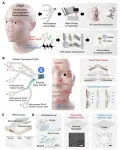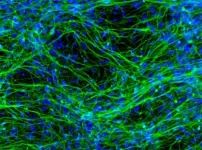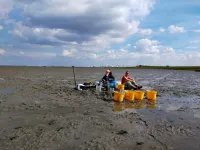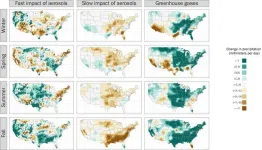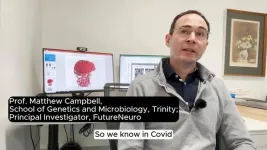(Press-News.org) From Bangladesh to India to Texas, Tom Varner is leveraging his research to improve sources for drinking water around the world.
Varner, a UTSA doctoral student in environmental science and engineering, explored the mobility of arsenic from the sediments surrounding the Meghna River in Bangladesh as part of a National Science Foundation-funded project.
The river flows through central Bangladesh, where elevated concentrations of arsenic in the groundwater threaten the welfare of millions of people. Long-term exposure to arsenic, which is toxic when ingested, can lead to cancer, epigenetic defects, vascular disease and other health ailments.
The project is a collaborative effort between researchers in the UTSA Department of Earth and Planetary Sciences, University Texas at Austin and Texas A&M University. Most recently, Varner traveled to India in spring 2023 to complete a Fulbright research project along the Hooghly River. The work complimented the work he did along the Meghna River in Bangladesh.
Varner is working under the mentorship of Saugata Datta, director of the UTSA Institute for Water Research, Sustainability and Policy. The graduate student’s work, which integrates aspects of science, engineering and public health to address water resources, carries significance outside the laboratory.
“This represents a new research topic for UTSA,” Datta, professor and chair in the UTSA Department of Earth and Planetary Sciences, said. “As part of the international scope of this research project, UTSA experiences a high level of interest from the international scientific community. Varner’s work has established the groundwork for many aspects in upcoming proposals, which once funded, confirm UTSA’s classification as an R1 university.”
Varner is investigating a phenomenon known as the Natural Reactive Barrier (NRB) along the Meghna River and Hooghly Rivers wherein the mixing of oxygen-rich river water and reducing groundwater in the riverbank facilitates the formation of iron-oxides, which can effectively remove the arsenic from the groundwater.
A robust understanding of this natural phenomena may be used to identify low arsenic groundwater zones along rivers where drinking wells may be safely installed and can be further extrapolated to understand the cycling of metals and contaminants along river corridors.
“Understanding more about these processes and the natural reactions that occur between the river and aquifer will provide the groundwork for future studies to understand how contaminants behave in the environment,” Varner said. “There are social benefits that can be applied as well; preventing exposure to arsenic in drinking water can help to improve the health of afflicted communities. The research also is relevant for environmental risk assessment and remediation projects dealing with groundwater contamination along river corridors.”
Although the study’s primary focus is within Bangladesh, Varner’s research provides insights into the universal processes regulating arsenic in groundwater. His work can be applied to further understand similar groundwater systems in local areas.
“For example, the iron-enriched sediments within the deltaic aquifers along the Brazos River in Texas and the nearby Mississippi River delta are also associated with elevated arsenic in the groundwater and parallel the conditions we have observed in Bangladesh,” Datta said.
Varner has produced six publications detailing the processes responsible for high and low arsenic concentrations along the Meghna and Hooghly Rivers. He’s also contributing two book chapters to the upcoming book titled “Advances in River Corridor Research and Applications,” detailing work along the Hooghly and Beas Rivers in India.
“UTSA has provided a great platform to jump out and do this research, from the financial support of grants from Dr. Datta and support from the EPS department to go to conferences. The Graduate School has provided support through various means, such as graduate student travel grants and award-based competitions such as the Transdisciplinary Team Grand Challenge. There’s always support there,” Varner said.
END
UTSA doctoral student studies solutions to prevent contaminated water sources
2024-02-22
ELSE PRESS RELEASES FROM THIS DATE:
Treating newly-diagnosed Crohn’s patients with advanced therapy leads to dramatic improvements in outcomes
2024-02-22
A large-scale clinical trial of treatment strategies for Crohn’s disease has shown that offering early advanced therapy to all patients straight after diagnosis can drastically improve outcomes, including by reducing the number of people requiring urgent abdominal surgery for treatment of their disease by ten-fold.
The PROFILE trial, led by researchers at the University of Cambridge, involved 386 patients with newly-diagnosed active Crohn’s disease. Recruiting from 40 hospitals across the UK, and supported by the National Institute for Health and Care Research (NIHR) Clinical Research Network, it sought to test whether a biomarker – a genetic signature ...
Uncovering anxiety: Scientists identify causative pathway and potential cures
2024-02-22
Anxiety-related disorders can have a profound impact on the mental health and quality of life of affected individuals. Understanding the neural circuits and molecular mechanisms that trigger anxiety can aid in the development of effective targeted pharmacological treatments. Delta opioid receptors (DOP), which localize in the regions of the brain associated with emotional regulation, play a key role in the development of anxiety. Several studies have demonstrated the therapeutic effects of DOP agonists (synthetic compounds which selectively bind to DOPs and mimic the effect of ...
Stronger storms free more nutrients from mud flats
2024-02-22
If storms become stronger in the future due to climate change, more nitrogen may be released from the bottom of coastal seas. This is shown by research of marine biogeochemist Dunia Rios-Yunes at NIOZ in Yerseke. Rios-Yunes will defend her PhD-thesis today at the University of Utrecht. “The dynamics of nutrients in deltas and estuaries have been a bit of a blind spot for marine science, so far”, she says.
Inflatable couch
For her experiments, Rios-Yunes spent many hours on an inflatable couch on ...
New study is first step in predicting carbon emissions in agriculture
2024-02-22
MINNEAPOLIS / ST. PAUL (02/19/2024)—For the first time, researchers at the University of Minnesota Twin Cities (UMN) and the University of Illinois Urbana-Champaign (UIUC) have demonstrated that it is possible to provide accurate, high-resolution predictions of carbon cycles in agroecosystems, which could help mitigate the impacts of climate change.
The study by scholars from the UMN-led National Artificial Intelligence Institute for Climate-Land Interactions, Mitigation, Adaptation, Tradeoffs and Economy (AI-CLIMATE) and UIUC-led Agroecosystem Sustainability ...
Air pollution hides increases in rainfall
2024-02-22
We know that greenhouse gas emissions like carbon dioxide should increase rainfall. The emissions heat the atmosphere, causing a one-two punch: warmer oceans make it easier for water to evaporate, and warmer air can hold more water vapor, meaning more moisture is available to fall as rain. But for much of the 20th century, that increase in precipitation didn’t clearly show up in the data.
A new study led by researchers at the Department of Energy’s Lawrence Berkeley National Laboratory (Berkeley ...
Damage to cell membranes causes cell aging
2024-02-22
Our cells are surrounded by a fragile membrane that’s only 5 nanometers thick, 1/20 of a soap bubble. Cells are easily damaged by physiological activities, including muscle contraction and tissue injury. To cope with such damage, cells are equipped with mechanisms that can repair membrane damage to a certain degree.
Mechanical damage to the cell membrane was previously believed to trigger two simple cellular outcomes: recovery or death. In this study, however, the researchers uncovered a third outcome – cellular senescence.
“When I started this project, I simply aimed to understand ...
Mice surprise: Australian researchers discover new native species
2024-02-22
Australia can lay claim to two new species of native rodent thanks to a study from The Australian National University (ANU).
The aptly named delicate mouse was previously thought to be a single species spanning a massive stretch of the country from the Pilbara in Western Australia, across parts of the Northern Territory and through Queensland down to the New South Wales border.
But researchers at ANU and CSIRO thought there might be more to the story.
Lead author Dr Emily Roycroft, from ANU, said we now know there ...
Latest research redefines neurodevelopmental risks, outcomes for congenital heart disease
2024-02-22
Statement Highlights:
A new American Heart Association scientific statement updates more than a decade of research identifying, managing and preventing neurodevelopmental delays and disorders among people with congenital heart disease.
The new statement outlines important changes since the Association’s last statement in 2012, such as revised criteria to determine which children and adults are at high risk for neurological developmental delays and disorders, as well as an updated list of factors that may increase the risk.
Critical next ...
Researchers discover underlying cause of “brain fog” linked with Long COVID
2024-02-22
Today, a team of scientists from Trinity College Dublin and investigators from FutureNeuro announced a major discovery that has profound importance for our understanding of brain fog and cognitive decline seen in some patients with Long COVID.
In the months after the emergence of the novel coronavirus SARS-CoV2 in late 2019 a patient-reported syndrome termed Long-COVID began to come to the fore as an enduring manifestation of acute infection.
Long COVID has up to 200 reported symptoms to date, but in general patients report lingering symptoms such as fatigue, ...
Carbon emissions from the destruction of mangrove forests predicted to increase by 50,000% by the end of the century
2024-02-22
The annual rate of carbon emissions due to the degradation of carbon stocks in mangrove forests is predicted to rise by nearly 50,000% by the end of the century, according to a new study published in IOP Publishing’s journal Environmental Research Letters. Mangroves in regions such as southern India, southeastern China, Singapore and eastern Australia are particularly affected.
Mangrove forests store a large amount of carbon, particularly in their soils, however human development in these areas has led to the degradation of these carbon ...

